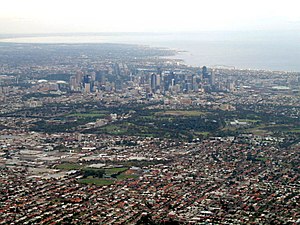 Image via WikipediaGoing down? Newman and Kenworthy on Peak Car Use (World Streets: The New Mobility Agenda, Jun. 23, 2011)
Image via WikipediaGoing down? Newman and Kenworthy on Peak Car Use (World Streets: The New Mobility Agenda, Jun. 23, 2011)And here: Peak car use: urban planning needs to change say Newman and Kenworthy (The FifthEstate, May 26, 2011)
Today, the focus is on the declining use of cars in cities as a result of several factors which started before the recent large increase in fuel prices. This lowering of reliance on cars is having major impacts on the rebirth of the inner city, the end of sprawl and, generally, a higher quality of life and cleaner air for those who live in the urban core.
Key Quotes:
“Getting control of car use overall, and more particularly in and around cities, is a critical building block of the strategy needed to ensure sustainability and social justice”
“The first signs of declining car use in cities are being observed…six interdependent factors are examined that could help to explain this unexpected phenomenon:
Hitting the Marchetti Wall:
- all cities have a similar average travel time budget of around one hour; a Walking City can expand to 5-8km wide before it becomes dysfunctional; a Transit City based on an average speed of 30 km/h for trains can extend to 30 km; Automobile City based on an average speed of 50 km/h in cars can reach out to 50 km wide
The Growth of Public Transport
-in ten major US cities from 1995 to 2005 transit boardings grew 12% from 60 to 67 per capita, five Canadian cities grew 8% from 140 to 151, four Australian capital cities rose 6% from 90 to 96 boardings per capita, while four major European cities grew from 380 to 447 boardings per capita or 18%
The Reversal of Urban Sprawl
-the return of small supermarkets to the central business districts of cities as residential populations increase and demand local shopping opportunities within an easy walk. Overall, this reversal of urban sprawl will undermine the growth in car use
The Aging of Cities
-People who are older tend to drive less
The Growth of a Culture of Urbanism
-older people move back into cities from the suburbs – the so-called ‘empty nester’ syndrome
The Rise in Fuel Prices”
-The vulnerability of outer suburbs to increasing fuel prices was noted in the first fuel crisis in 1973-4 and in all subsequent fuel crisis periods when fuel price volatility was clearly reflected in real estate values"
Related articles
- We Are Approaching Peak Car Use (fastcompany.com)
- Peak oil? Now its peak cars (friendsofbanyule.wordpress.com)
- Car switch under fuel price rise (autonetinsurance.co.uk)
- Only a fifth opt for car sharing (autonetinsurance.co.uk)
- Paying the real price for urban sprawl (theglobeandmail.com)

No comments:
Post a Comment